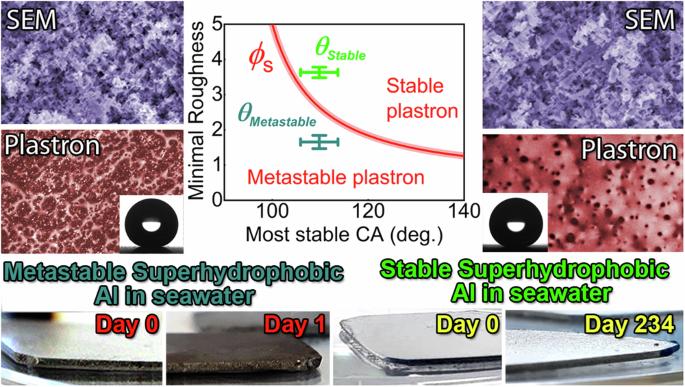预测水下超疏水的质点热力学稳定性
IF 7.5
Q1 MATERIALS SCIENCE, MULTIDISCIPLINARY
引用次数: 0
摘要
非润湿表面,尤其是那些能够在粗糙突起中被动捕获空气的表面,可以提供表面弹性,抵御与润湿相关现象的有害影响。然而,由于缺乏能够明确区分稳定和非稳定卡西-巴克斯特润湿机制的评估标准和方法,这种具有持久夹带空气层(称为plastron)的超疏水性表面的开发受到了阻碍。常用的接触角测角法缺乏评估润湿机制稳定性的信息。因此,有必要确定哪些表面特征可作为识别热力学稳定质点的标志。在此,我们介绍了一种通过测量表面粗糙度、固液面积分数和杨氏接触角来评估超疏水表面卡西-巴克斯特润湿机制的热力学水下稳定性的方法。该方法可预测连续浸没一年以上的被动底盘稳定性、对贻贝和藤壶粘附的阻碍以及对海水中金属腐蚀的抑制。这种浸没稳定的超疏水性,即在环境条件下,固体基底和周围液体之间的稳定被动空气层能长时间排斥水,为需要固体与水介质持续接触的科学和技术开辟了新的途径。超疏水表面在浸入水中后会捕获一层空气,称为 "plastron",将其与周围的液体隔开。本文报告了通过测量表面粗糙度、固液面积分数和杨氏接触角来预测 plastron 热力学稳定性的方法。本文章由计算机程序翻译,如有差异,请以英文原文为准。

Predicting plastron thermodynamic stability for underwater superhydrophobicity
Non-wettable surfaces, especially those capable of passively trapping air in rough protrusions, can provide surface resilience to the detrimental effects of wetting-related phenomena. However, the development of such superhydrophobic surfaces with a long-lasting entrapped air layer, called plastron, is hampered by the lack of evaluation criteria and methods that can unambiguously distinguish between stable and metastable Cassie-Baxter wetting regimes. The information to evaluate the stability of the wetting regime is missing from the commonly used contact angle goniometry. Therefore, it is necessary to determine which surface features can be used as a signature to identify thermodynamically stable plastron. Here, we describe a methodology for evaluating the thermodynamic underwater stability of the Cassie-Baxter wetting regime of superhydrophobic surfaces by measuring the surface roughness, solid-liquid area fraction, and Young’s contact angle. The method allowed the prediction of passive plastron stability for over one year of continuous submersion, the impeding of mussel and barnacle adhesion, and inhibition of metal corrosion in seawater. Such submersion-stable superhydrophobicity, in which water is repelled by a stable passive air layer trapped between the solid substrate and the surrounding liquid for extended periods at ambient conditions, opens new avenues for science and technologies that require continuous contact of solids with aqueous media. Upon submersion, a superhydrophobic surface can trap a layer of air, termed “plastron”, that separates it from the surrounding liquid. Here, methodology is reported for predicting the thermodynamic stability of plastron by measuring surface roughness, solid-liquid area fraction, and Young’s contact angle.
求助全文
通过发布文献求助,成功后即可免费获取论文全文。
去求助
来源期刊

Communications Materials
MATERIALS SCIENCE, MULTIDISCIPLINARY-
CiteScore
12.10
自引率
1.30%
发文量
85
审稿时长
17 weeks
期刊介绍:
Communications Materials, a selective open access journal within Nature Portfolio, is dedicated to publishing top-tier research, reviews, and commentary across all facets of materials science. The journal showcases significant advancements in specialized research areas, encompassing both fundamental and applied studies. Serving as an open access option for materials sciences, Communications Materials applies less stringent criteria for impact and significance compared to Nature-branded journals, including Nature Communications.
 求助内容:
求助内容: 应助结果提醒方式:
应助结果提醒方式:


